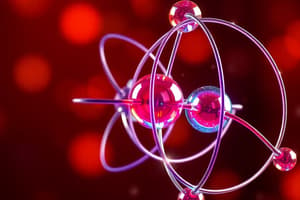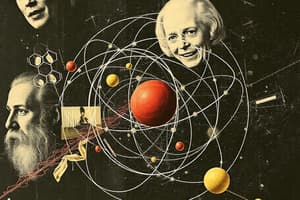Podcast
Questions and Answers
What does the principal quantum number (n) indicate?
What does the principal quantum number (n) indicate?
- The spin of the electrons
- The energy level of electrons (correct)
- The shape of the orbital
- The orientation of the orbital
Atomic orbitals are defined by a set of three quantum numbers.
Atomic orbitals are defined by a set of three quantum numbers.
False (B)
What is the volume of space that contains electrons around the nucleus called?
What is the volume of space that contains electrons around the nucleus called?
atomic orbital
The principal quantum number is denoted by the letter ______.
The principal quantum number is denoted by the letter ______.
Match the quantum numbers with their descriptions:
Match the quantum numbers with their descriptions:
Study Notes
Atomic Orbitals
- An atomic orbital is the three-dimensional region around the nucleus of an atom where an electron is most likely to be found.
- Atomic orbitals are described by a set of four quantum numbers.
- The principal quantum number (n) describes the energy level of an electron. Higher values of 'n' correspond to higher energy levels.
- The rows of the periodic table are called periods and correspond to the principal quantum number (n).
- The columns of the periodic table are called groups, and some groups have specific names like halogens or noble gases.
- Elements can increase their covalent bonding capacity by promoting electrons to higher energy levels, which requires energy.
- Covalent bonds can be nonpolar or polar.
- In nonpolar covalent bonds, the electron pair is shared equally between the two bonded atoms, such as in homonuclear diatomic molecules (H2, Cl2, N2).
- A C-O bond contains two pairs of electrons.
- Sigma bonds are formed by the overlap of sp orbitals on carbon with singly occupied p orbitals on oxygen.
Studying That Suits You
Use AI to generate personalized quizzes and flashcards to suit your learning preferences.
Related Documents
Description
Explore the fundamental concepts of atomic orbitals and covalent bonds in this quiz. Understand the significance of quantum numbers, energy levels, and how bonds can be classified as polar or nonpolar. This quiz delves into the arrangement of elements in the periodic table and the nature of covalent bonding.




